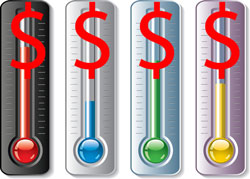Benchmarks and industry rules of thumb are typically used by lazy or uninformed people who don’t understand basic finance theory. Here are 5 compelling reasons why:

Source of the Data is Unreliable: Do you actually know where the data has come from? Did you know that the only mandatory reporting for small business is to the tax authorities? Do you think that every business in your industry reports the true performance of their business to the tax office? I’m not just talking about tax evasion issues, but also that the tax laws have rules for calculating profits that are very different to the normal accounting rules. This could be due to the timing of income and expenses or whether something is an asset or an expense or how depreciation, amortisation and interest are accounted for. Taxable profit is an extremely unreliable measure of real profit.
I’ve seen other benchmark data from even more unreliable sources like phone surveys, business for sale listings and the like. None of them are confirmed or audited in any reliable way so you have to be careful if using this data if you’re trying to make real world decisions.
Accounting is not an Exact Science: Let’s pretend for a moment that the data source is reliable and all figures were audited and confirmed. Even if this is the case you need to be aware that accounting is not an exact science, apart from the debits needing to equal the credits. Let’s say you are a cafe trying to compare your gross profit margin percentage (sales less direct cost of sales, divided by sales) against the benchmark. Assume that the data said that the average gross profit margin was 30%. That is for every $100 of sales you should have $70 of direct costs, leaving $30 in gross profit before overheads. Seems easy enough to compare but here is the problem…
What types of expenses are direct expenses in the benchmark data? I can probably assume food and beverage purchase costs are included can’t I? But what about wages? Is the chef’s wage a direct expense or just an overhead? What about advertising and sales commissions? What about packaging costs for take-aways? What about disposable napkins etc? The problem is that every accountant has a different opinion on these things so the benchmark data is effectively useless. This is not just an issue for the gross margin, it happens throughout the entire profit and loss and balance sheet.
Have the Working Owners Been Paid: This is a huge problem with analysing any small business. On the face of it, the business could look profitable. For example, I recently undertook a business valuation for an accounting firm. It was making decent profit of around $100,000 so at first glance it looked like a successful business. But the problem is that the partner hadn’t yet paid himself a wage. The market wage would be at least $120,000 to employ someone to do what the partner does. And the partner would certainly earn more than that if he worked the same hours for someone else. The reality is that the business was not successful at all in terms of real return on investment.
Whenever I undertake an independent business valuation I rip apart the profits and re-create them because the real profit is often very different to what it first appears.
Why do people Care so Much About Revenue?: The laziest thing you will come across is any kind of rule of thumb that uses total revenue (before expenses) as the sole basis for the business valuation. It happens in many industries, mine included, and accountants should know better. Generally accountants value their own businesses at around $1 for every dollar of revenue in the past year. So a business with revenue of $1m is worth around $1m. The problem is that an owner or investor doesn’t care about revenue, they only care about profit and in fact they go a step further and only really care about what they can bank, which is net cashflow from dividends and capital gains.
Here is a simple example of why this kind of rule of thumb is so ridiculous. You could have two firms both with revenue of $1m. One is does cheap tax returns and makes $100,000 profit and the other provides great business advice to a recurring customer base and makes $400,000 profit. Why on earth are these business worth the same under the industry rule of thumb? And this happens in almost every industry. These myths are propagated by uninformed or negligent people in positions of trust who spread these things like they know what they’re talking about. You can probably tell that I get annoyed by these kinds of things and it breaks my heart when people spend way too much money on a business using these shortcuts because they don’t think they need an independent valuation. I see it far too often.
Your Business is Unique:Have you ever wondered why one or two businesses in every industry seem to flourish, a few make a stable living and the rest struggle to break even? Have you seen this in a restaurant precinct where one or two restaurants do well and all the others constantly change hands due to liquidation. This is a case in point. They are in the same location, with the same macroeconomic and local socioeconomic conditions, same pool of employable staff and the same marketing opportunities. A business is made up of the thousands of little things, each of which make it unique. What the restaurant next door sold for yesterday has little if nothing at all to do with what your restaurant is worth today. But hey, if the uninformed are advising the uninformed then anything can happen…and often does.
The Lessons: I’ve been analysing businesses and working as an independent business valuer for many years. I am yet to see two identical businesses. I read all of the 1,000 page text books on business valuation theory and methods and attend every conference I can find on the topic. I am yet to see or hear of someone who can explain to me how industry benchmarks make sense as a sole method of analysis or valuation. Sure it certainly doesn’t hurt to have a quick look out of curiosity or to compare the outcomes against other methods…but if you can’t equate the performance back to net cash flow and the risk-return trade-off, then it’s not useful in the real world.
Follow me on facebook, linkedin, twitter and google+ for more.

